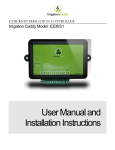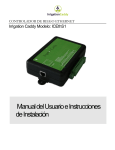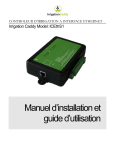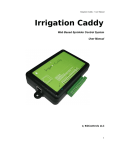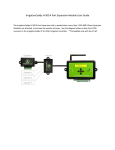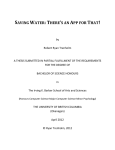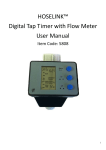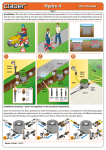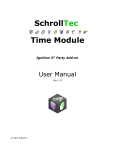Download User Manual and Installation Instructions
Transcript
ETHERNET IRRIGATION CONTROLLER Irrigation Caddy Model: ICEthS1 User Manual and Installation Instructions IRRIGATION CADDY MODEL: ICETHS1 User Manual and Installation Instructions KGControls LLC 2606 Orsobello Place Cedar Park, TX 78613 USA Email: support@IrrigationCaddy.com U S E R M A N U A L A N D I N S T A L L A T I O N I N S T R U C T I O N S Table of Contents Installation ........................................................................................ 3 Introduction ...............................................................................................3 Installation Steps .......................................................................................3 Steps: ..........................................................................................3 Mounting on the Wall ................................................................................4 Connecting Valve Wires ............................................................................5 Steps: ..........................................................................................5 Usage ................................................................................................. 6 Setting the Clock .......................................................................................6 Steps: ..........................................................................................6 Setting a Program’s Schedule ..................................................................8 Turn the program ON or OFF .......................................................8 Selecting which days to run .........................................................8 Start Times ................................................................................ 11 Setting zone run times ............................................................... 11 Using the “Run Now” Program ............................................................... 12 Status Area .............................................................................................. 13 Turning the system OFF ............................................................ 13 Stopping Individual Zones .......................................................... 13 Calendar ................................................................................................... 14 Settings ........................................................................................... 16 Firmware Version .................................................................................... 17 Clocks ...................................................................................................... 17 Network Settings ..................................................................................... 17 Zone Names ............................................................................................. 18 Authentication ......................................................................................... 19 Other......................................................................................................... 20 Resetting to Factory Defaults ................................................................. 20 Index ................................................................................................ 21 1 U S E R M A N U A L A N D I N S T A L L A T I O N 2 I N S T R U C T I O N S U S E R M A N U A L A N D I N S T A L L A T I O N I N S T R U C T I O N S 1 Chapter Installation Introduction The Irrigation Caddy (IC) is an Ethernet irrigation controller. The IC allows the user to control and schedule an irrigation system from any computer with a web browser. No special software or clients are required, just a Web Browser on a computer or internet enabled device. The IC can be used in new installations or as a replacement for an existing sprinkler control system. The IC supports up to 10 different irrigation zones. If your system uses a master valve, one of the outputs will be used as the master valve control, thus allowing only a maximum of 9 zones. Out of the box the IC is configured with output #10 set as the master valve output. Installation Steps W A R N I N G info NOTE: The Irrigation Caddy is an indoor device. Make sure the device is placed indoors in a dry protected area. Exposure to rain and extreme weather conditions will damage the device. Steps: 1. Find an appropriate location for the IC, and hold the enclosure in place. 2. Using a pen make marks through the screw mounting holes (A) on the plastic ears protruding from the enclosure. 3. NOTE: If installing on Drywall make sure you use screw anchors 4. Put the device aside, and drill a hole on each one of the marks you made. 5. Put the Irrigation Caddy back in place and insert the screws through the mounting holes. 3 U S E R M A N U A L A N D I N S T A L L A T I O N I N S T R U C T I O N S Mounting on the Wall Figure 1 Views all sides A. Screw mounting hole B. Power connector ( 24VAC ) C. Valve connector. D. Rain sensor connector. E. Ethernet connector F. Reset button hole. G. Power light indicator. 4 U S E R M A N U A L A N D I N S T A L L A T I O N I N S T R U C T I O N S Connecting Valve Wires Steps: 1. If this is a replacement installation, first remove the old Sprinkler Control System, and attach the IC to the wall. Make sure the valve cables can reach the IC. 2. Identify the common cable and connect it to the “com” output. 3. Connect valves 1 through 9, to the corresponding outputs on the IC 4. If your installation includes a master valve, connect the master valve to output #10 (“10 | MV”). 5. Connect a network cable from a network switch, or your Cable / DSL Router to the IC (E). 6. Connect the power cable to the IC using the “AC1” “AC2” (B) outputs using the connector provided. 7. Plug the wall transformer to a power outlet. 8. The IC should now be installed, and ready to use. 9. Go to a computer connected to the same network as the IC, and type http://irrigationcaddy NOTE: If your browser does not recognize http://irrigationcaddy, try using the IP Address. (http://<IP Address>) You can obtain the IC’s IP Address from your router, info or you can download the IrrigationCaddySniffer network utility from our website, here: W A R N I N G http://www.irrigationcaddy.com/Documentation.html 5 U S E R M A N U A L A N D I N S T A L L A T I O N I N S T R U C T I O N S 2 Chapter Usage Going to the http://irrigationcaddy web address will present you with a Web Interface to the IC. The IC is capable of scheduling irrigation times using three different programs, which can be scheduled independently. The IC also provides the user with a “Run Now” program, which allows the user to execute a one time schedule, immediately after programming. Setting the Clock It is important that you set the IC’s clock time to the current time. Steps: Figure 2 Selection Column 1. Click on “Settings”. 2. Click on “Clocks”. 6 U S E R M A N U A L A N D I N S T A L L A T I O N I N S T R U C T I O N S Figure 3 Clock settings 3. Set the time: a. You can use the “Synch Clocks” button to synch the IC’s clock with your computer’s clock. b. You can also manually set it by clicking on the field next to the “Set Datetime” button. Figure 4 Modifying the system time 7 U S E R M A N U A L c. A N D I N S T A L L A T I O N I N S T R U C T I O N S It is also possible to set the time using NTP (Network Time Protocol). Click on the “Use NTP Time” checkbox to enable the NTP time feature. NTP will try to connect to the “NTP Server” listed every few minutes, and update the local clock. A “Timezone” will also have to be specified. Figure 5 NTP Time Settings 4. Once the IC’s clock has been set, this step does not have to be repeated. Setting a Program’s Schedule Turn the program ON or OFF Turn the program ON by checking the “ON/OFF” check box at the top. If you leave the box unchecked, the settings will be saved as expected, but the schedule will not run. Figure 6 Turning programs on and off Selecting which days to run First select the program you would like to configure. 8 U S E R M A N U A L A N D I N S T A L L A T I O N I N S T R U C T I O N S Figure 7 Program Selection The IC supports several different programming schemes INDIVIDUAL DAYS With this scheme you set what days of the week you would like to run your sprinklers. The program will then start only on the days you selected. Figure 8 Individual day selection EVEN / ODD DAYS With this scheme you select whether you would like the system to run on only even numbered days (2, 4, 6 etc) or odd numbered days (1, 3, 5 etc). Then you would select the individual week days you would like the system to run on. This way you can tell the system to run on even days, but not on weekends for example. 9 U S E R M A N U A L A N D I N S T A L L A T I O N I N S T R U C T I O N S Figure 9 Even / Odd Day Selection 1 If you would like to run even or odd days regardless of what day of the week it is then you would select every day of the week. Figure 10 Even / Odd day selection 2 EVERY N DAYS With the Every N Days option you can tell the system to run exactly every specified number of days (i.e. every 3 days). As with the Even / Odd option, you can combine this option with the individual days, and also restrict which days of the week the system should run. For example you can tell the system to run every 2 days except for Mondays, and Wednesdays. Figure 11 Every N Days interval and day selection Every time the program is changed, and saved, the system will reset the time the program last run on, and start counting from the Sunday closest to 31 days prior to the current date. So if you make a change to a program that is set to run every 3 days, no matter what day it was last run, it will start counting from the Sunday closest to the date that falls 31 days prior to today. 10 U S E R M A N U A L N O T E Info A N D I N S T A L L A T I O N I N S T R U C T I O N S The Even / Odd Days and Every N Days options cannot be combined. Once one is selected the other is disabled. If the Every N Days options has a number of days selected other than “-“, the Even / Odd option will not be available. Set the Every N Days number of days to “-“ before selecting the Even / Odd option. Start Times The IC provides up to 5 start times per program. The start times are used to run the same program at different times during the day. For example, in certain scenarios it makes sense to water the same areas twice a day, once early in the morning and once later in the day. This can be accomplished by enabling one extra start from start times number 2, 3, 4 or 5. Start time 1 is always enabled, and it is the default start time. In other scenarios, where water runoff is a concern, the programs can be shortened, but more start times can be enabled thus maintaining the total amount of water output desired, while preventing runoff. To select the program’s start time click on the text field below the “Start Time” heading, and a time picker will display. Then select the start time using the sliders. Figure 12 Program start time selection Setting zone run times To set the zone run times, under the “Run Times” heading, move the slider to the right to increase the amount of time a zone should run. The run time will display on top of the slider as well as to the right of the slider. Figure 13 Zone run time 11 U S E R M A N U A L A N D I N S T A L L A T I O N I N S T R U C T I O N S A. Minimum time boundary B. Maximum time boundary. The zone cannot be set to run for more than the high time boundary. This limit can be changed from the settings page. C. The slider. D. The amount of time the zone will run. Using the “Run Now” Program The “Run Now” program allows you to run the system at the current moment. Just set the duration times on each one of the zones you are interested in running, and click on the “Run Now” button. This will start the system immediately. 12 U S E R M A N U A L A N D I N S T A L L A T I O N I N S T R U C T I O N S Status Area The status area is divided in 5 sections. 1. The first section shows the system time. 2. The second section indicates whether the system is ON or OFF, and it allows the user to turn the system ON or OFF. 3. The third section indicates the rain sensor status. 4. The fourth section indicates the run time remaining for a program and for the zone currently running within that program. It also allows the user to stop the zone. 5. The last section is a global status area for the zones. ON will display for a zone currently running, WAIT is for a zone that will run in the future after the zones above it have finished running, and OFF indicates the zone has already run, or the zone will not run at all. Turning the system OFF During the winter months you may not want to run the system. In that case, you can turn the system OFF by clicking on the “OFF” button in the “System” section. When you want the programs to run again, you would simply click on the “ON” button. Note the system would still be powered on, but it will not turn on the sprinklers. Stopping Individual Zones While a program is running, you can stop individual zones by clicking on the “Stop Zone” button in the “System” section. If there is a zone waiting to run, that zone will then take over and start. If for some reason you would like to stop the program from continuing to run, you could click on the “Stop Zone” button for each one of the zones scheduled to run until there are no more zones ready to run. 13 Figure 14 System Status Area U S E R M A N U A L A N D I N S T A L L A T I O N I N S T R U C T I O N S Calendar You can see a visual representation of when then programs will run by clicking on the “Calendar” link. Figure 15 Calendar link There are three possible calendar views, “month”, “week”, and “day”. By default “month” will display but you can change the view by clicking on the appropriate button on the top right hand corner of the view. Figure 16 Selecting calendar view The following is an example “week” view, where you can clearly see Program 1 will run on Monday starting at 6am, Program 2 will run on Wednesday starting at 10am, and Program 3 will start on Thursday at 8pm. 14 U S E R M A N U A L A N D I N S T A L L A T I O N I N S T R U C T I O N S Figure 17 Calendar view 15 U S E R M A N U A L A N D I N S T A L L A T I O N I N S T R U C T I O N S 3 Chapter Settings The settings page can be accessed by clicking on the “Settings” link. Figure 18 Settings Link Once you access the settings page the system settings are subdivided into sections. Figure 19 Settings sections 16 U S E R M A N U A L A N D I N S T A L L A T I O N I N S T R U C T I O N S Firmware Version This section displays the firmware version the system is currently configured with. Figure 20 Firmware version Clocks It allows the user to set the system clock (see “Setting the Clock” under Usage) Figure 21 System Time Network Settings The section displays the current network system settings and also allows for setting the hostname, DHCP or Static IP address configuration, IP Address (if static was chosen), port number, default gateway, and network mask. 17 U S E R M A N U A L W A R N I N G A N D I N S T A L L A T I O N I N S T R U C T I O N S Unless you are proficient with network terms, and understand how devices communicate in an Ethernet network, it is recommended that you don’t change the default settings. Info Figure 22 Network settings Zone Names This section allows for the setting of the zone names. By default the zones are numbered and the names are empty. By giving a zone a descriptive name it is easier to remember which zone waters what area. 18 U S E R M A N U A L A N D I N S T A L L A T I O N I N S T R U C T I O N S Figure 23 Zone names Authentication In here you can enable or disable authentication. By default authentication is disabled. By turning authentication ON, and setting a username and password, the next time you try to access the device you will be prompted for a username and password. If the credentials you enter don’t match the credentials you specified here, you will not be allowed access to the IC’s interface. If you forget the username and password, the only way to access the IC is to reset it to its factory default settings by (See Resetting to Factory Defaults) Figure 24 Authentication 19 U S E R M A N U A L A N D I N S T A L L A T I O N I N S T R U C T I O N S Other This section is reserved for other unrelated settings. Two settings are available, “Use Sensor 1”, and “Max Zone Run Time”. “Use Sensor 1” is intended to be used with a rain sensor. When a rain sensor is plugged into the rain sensor connector, you can use this setting to tell the system whether it should pay attention to the sensor or not. If the “Use Sensor 1” setting is checked the system will check for a rain sensor, and if a sensor is present, it will water or stop watering according to the sensor state. If the sensor is wet, the system will not water. “Use #10 as Master Valve” provides for the ability to dedicate a zone as a “Master Valve”. This means that if this setting is checked, every time a regular zone turns on, the #10 zone will also turn on. This zone can also be used to trigger a pump start relay. In systems where a water pump is used, a pump relay can be connected to zone #10 while this setting has been enabled. Every time a zone turns on due to the schedule, the pump relay would get triggered. The “Max Zone Run Time” setting is intended to globally limit the maximum amount of run time that a zone can be set at. The main purpose of the setting is to prevent programming mistakes and avoid unintended long periods of watering. Figure 25 Other settings Resetting to Factory Defaults To reset the IC to its factory default settings, find the small pin hole next to the Ethernet connector on the side of the enclosure, and insert the end of a paper clip into it pushing in. Then while still pushing the paper clip in, turn the IC OFF by unplugging its power source, and then applying power again. Wait 10 seconds while still holding the clip down, and then let it go. The IC should now be reset. 20 U S E R M A N U A L A N D I N S T A L L A T I O N I N S T R U C T I O N S Index Authentication, 19 Calendar, 14 clock, 5, 6, 8 common. See Connecting Valve Wires Connecting Valve Wires, 3 DHCP. See IP Drywall. See Mounting on the Wall Ethernet, 0, 1 even. See EVEN / ODD DAYS Even / Odd Days, 9 Every N Days, 10 indoor, 1, See Installation Steps Installation Steps, 1 IP Network, 17 Static, 17 master, 1, 3 Mounting on the Wall, 3 Network Settings, 17 odd. See EVEN / ODD DAYS rain sensor, 13, 20 reset, 21 Resetting to Factory Defaults, 21 Run Now, 5, 12 schedule, 1, 5, 8 Settings, 16 Static IP. See IP Zone Names, 19 DHCP, 17 21
























